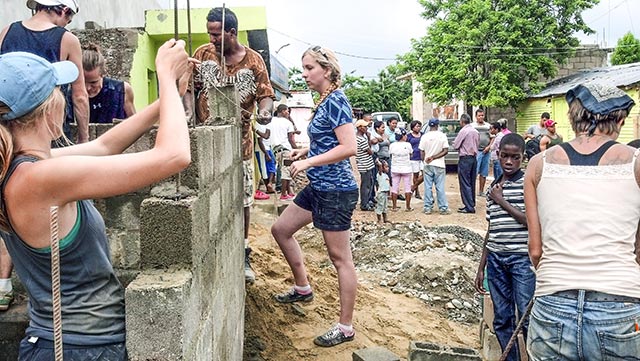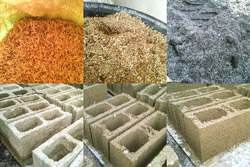“You don’t have to be studying engineering to join us,” said Grafman, who began the annual study abroad effort in 2005. “Students majoring in Spanish, social sciences and many who are still in general education can all benefit.”

All of the approximately 15 students – some of whom attend other U.S.-based universities – combine with a group of local college students and citizens to address community needs in the Dominican Republic. Continuing their focus on sustainable technologies, last summer’s team designed and built a public pharmacy using plastic bottles and other structural materials made from rice husks, rice husk ash, lime, cement and sand. They also installed a rainwater catchment system for a grade school in La Yuca and constructed a renewable energy system for an animal shelter.
“We’re never certain as to what we’re going to do there, only that it will be a combination of building and using renewable resources,” Grafman said. “Whatever we’re working on, it’s a collaboration of U.S. students, Dominican students and community members. We start by getting together in a big room and identifying our physical resources and individual strengths, whether it’s welding or singing. Then we combine them in a community process.”
All of the students involved in Practivistas also gain cultural awareness while living with a Dominican family and studying alongside local students. Far from tourists, they spend six weeks interacting as contributing members of the community.

“The most memorable part of my experience was the bonds I formed with the people I met,” said Camille Penny (Environmental Resources Engineering, ’15), who participated in 2012 and returned as a teaching assistant for the 2013 session. “Memories of my host mom will always be in my heart. A specific memory is of me trying to show her my appropriate technology homework in the evenings, though I spoke no Spanish and she spoke no English.”
With long, wavy locks and a sun-drenched complexion, Grafman looks every part the hands-on design engineer and builder. It’s his eyes and quick smile, however, which reveal a passion that fuels his wide variety of appropriate technology efforts.
Along with teaching two to three classes per semester at HSU, Grafman spends an average of 3-5 months abroad each year traveling throughout the U.S. and Latin America, providing assistance and advice to other university groups with similar programs. “I’ve learned to get by on a limited amount of sleep,” he said.
Grafman is also the founder and president of Appropedia, an interactive online center focusing on sustainability, appropriate technology and poverty reduction that currently features 5,715 contributed articles. Available at http://www.appropedia.org/, the website has seen roughly 250,000 edits provided from among its 50 million views.
At the heart of all of Grafman’s activities are the students who take the lessons with them beyond Humboldt State, applying the knowledge gained in a variety of careers.
“I hope to incorporate many of the aspects of the Practivistas Dominicana program into my professional future,” Penny said. “I think it is an incredibly valuable program, with its focus on service learning and sustainability, that would bring fulfillment to any career. More important, the benefits would be widespread and diverse for others as well.”
One of those immediate benefits, according to Grafman, is the collaborative experience gained by students and members of the communities where they study and work. He’s quick to point out that the Practivistas program isn’t a charitable venture.
“When we started working in some of these communities, I think many of the people found us annoying. When they realize we’re not on a charity mission, they become involved themselves. There’s a deep engagement when you go through the successes and failures together. The result, when it’s done, is a sense of love, not thanks.”